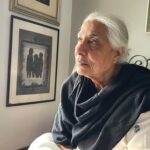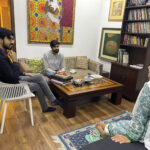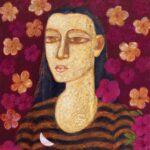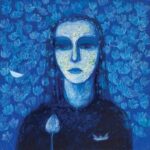Currently Empty: ₨0.00
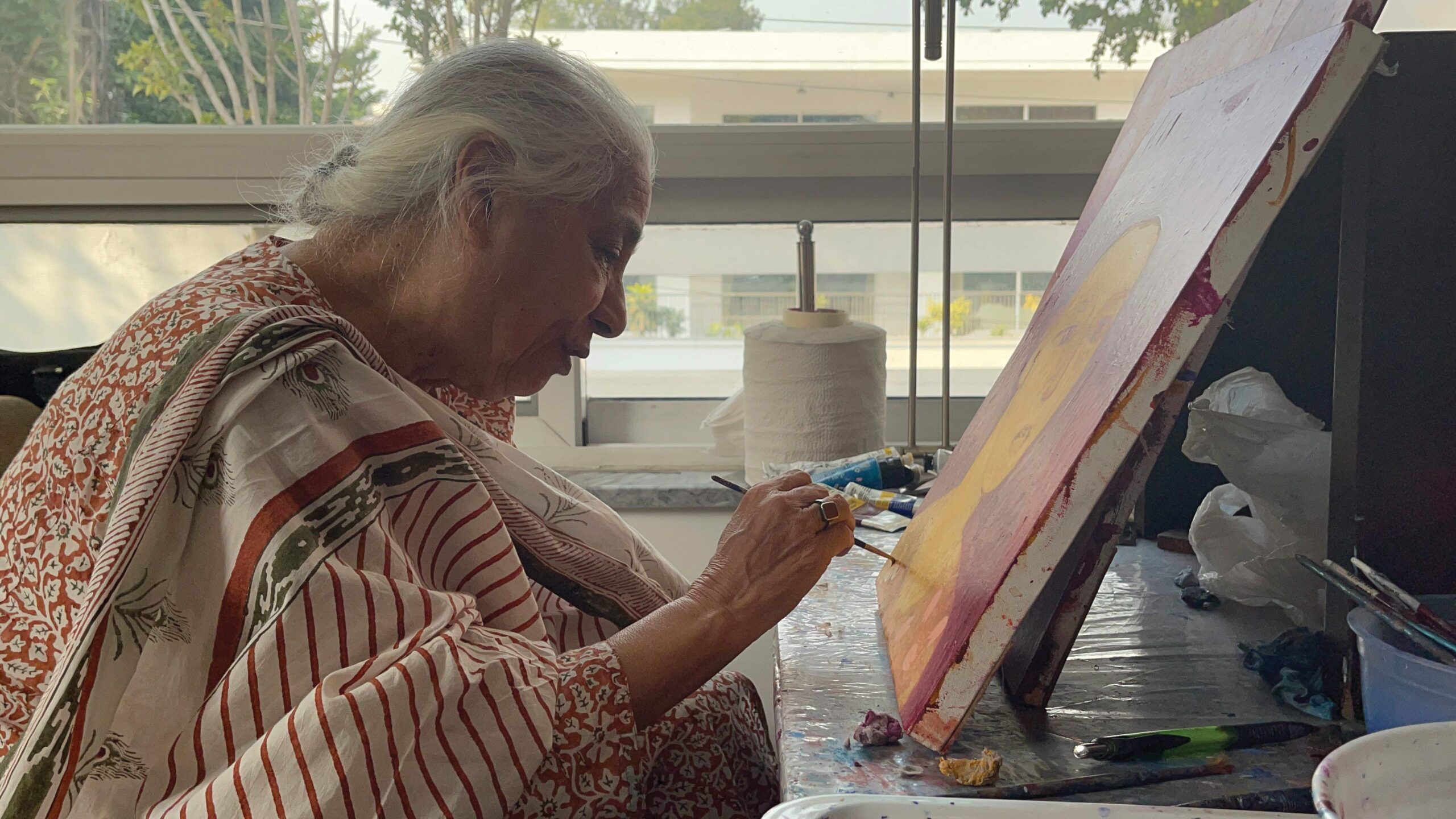
MEHER AFROZ
In a quiet corner of the residence, in the heart of Lahore, resides Meher Afroz. As I step into her make-shift (for her month-long residency) studio; her chosen refuge, the air is thick with the fragrance of paints and carries the whispers of a lifetime of devotion and tranquility. Meher’s oeuvre stands as a testament to the intricate dance between tradition and modernity. In Meher’s hands, the canvas becomes a reflective surface, mirroring the nuanced experiences of a society in flux. The room echoes a silent conversation between mentorship and curiosity.
Lined along the low walls and bits of furniture, lies an unfinished body of work for her upcoming exhibition, each canvas an open dialogue & a glimpse into the word “Imkaan”. And so, the conversation unfolds.
WIS: In light of your prior involvement as a resident artist at Studio RM a few years ago, can you share what stood out to you this time? How was your time in Lahore and your interactions with the people here?
MA: During our last artists’ gathering, the diverse energy and myriad of artworks sparked dynamic dialogues. Sana Arjumand, a decade younger back then, exuded remarkable energy, passion, dedication, and technique. She was truly inspiring. Another artist, Jaghat Ravindra from Sri Lanka, was remarkably humble. The communal exchange in such a group enriches one’s information, understanding, and technique.
My recent experience held its own charm. Although time constraints limited my artwork production, fulfilling responsibilities when invited is a given. I engaged in frequent interactions with various people, including young artists, seniors, and friends. It’s always heartening to see the tradition of artistic gatherings persisting at Studio RM in Lahore, a city that has maintained this practice since before partition. Unfortunately, Karachi lacks similar initiatives due to minimal state support and individuals’ time constraints. Some galleries attempted this in the past but evolved into more commercial spaces, creating a sense of detachment for artists. Only a few places, like Imam Saahib’s Indus Gallery, used to uphold these traditions, and following that, Chowkandi Art Gallery. However, I think even this practice is slowly fading. The future remains uncertain, but we must hope for the best.
WIS: How important do you think it is for residencies to acknowledge and celebrate senior artists alongside the usual recognition given to young talents?
MA: Back in India, when we were invited for state-organized residencies, there was a thoughtful pairing of younger artists with established figures in their respective fields, like printmakers with printmakers or painters with painters. Occasionally, even two renowned artists were included if the group was sizable. This approach not only allowed individuals to pursue their work while benefiting from the knowledge of their predecessors. It was an honor for students to collaborate with their idols. I’ve suggested a similar model to a few galleries here. If they have the facilities, why not? In India, state funding ensured that the produced work was usually donated, generating funds for the next residency and sustaining the program.
The specific art retreat program at Studio RM provided me with a unique platform to connect and share my knowledge and experiences with the youth. This extended not only through my work but also through various artist talks, such as those held at Punjab University and N.C.A.
WIS: Regarding the state’s role in the art scene, what are your thoughts on individuals and the private sector stepping in to support artists?
MA: I believe it’s the state’s role to support the arts, but currently, artists are taking the lead. A significant drawback is that paintings sold in private collections become inaccessible to the common person unless they have connections. If the state invested in art, we might have a national collection, fostering visibility. This absence means younger generations miss out on understanding the evolution of our art and may feel disconnected from our artistic history. State collections could provide a continuous view of past works, showcasing our artistic journey. Unfortunately, much of the great work by past artists remains in private collections, limiting public exposure.
WIS: Teaching at Indus for nearly 25 years, what changes have you noticed in students, the dynamics of student-teacher relationships, and the landscape of the artistic community?
MA: Private institutions here, particularly in a commercial city like this one, are often situated in posh areas, drawing students from families with fewer life difficulties. These students typically come from good English-medium colleges, which may restrict the diversity in their experiences.
On the other hand, those who have faced hardships, like individuals from remote areas such as Quetta, bring a more genuine and unfiltered perspective. They don’t need to ponder what to work on; their experiences and struggles guide them. Despite private institutions having an aptitude test allowing entrance to a diverse array of students, the environment isn’t always inclusive, making students from Urdu-speaking backgrounds feel uncomfortable due to a so-called Gora Saahib mentality.
Moreover, some private institutions seem to deviate from their initial commitment and mission statements, especially concerning respect. Even highly respected individuals, like the late Akbar Naqvi, who taught History for free out of passion, faced dissatisfaction. Institutions must revisit and rethink their commitment to respect both students and teachers. They also grapple with commercial challenges, avoiding external help and sometimes employing fresh graduates as teachers. While keeping them is essential, providing a transition period—say, 2 or 3 years—for them to gain experience and face challenges outside their academic comfort zone could be beneficial.
WIS: How do you determine the medium through which you wish to express yourself and create art? Whether it’s printmaking, drawing, painting, installations, or art performances, what influences your choice?
MA: Curators often play a role in determining the artistic medium, and initially, I was hesitant to experiment. However, with encouragement, I explored various possibilities—realizing that conveying a message extends beyond traditional mediums. It can be through speech, conduct, or by creating a unique environment. Artists should embrace challenges as language evolves, and to stay relevant, one must adopt contemporary forms. What worked 50 years ago is now part of history. Adapting to changing norms and values is crucial for staying in the field.
I frequently emphasize the importance of literature, be it in English, Urdu, Faarsi, or any other language. Diversifying your reading enriches your vision, education, and information, offering more options for your work. Everyone expresses themselves uniquely. Lately, I’ve found enjoyment and challenge in performances, expanding my artistic horizons.
WIS: How do you incorporate religious references into your work?
MA: I’ve titled the upcoming exhibition “Imkaan,” which translates to possibilities in English. While the English word feels light, “Imkaan” carries more depth, suggesting limitless exploration regardless of feasibility. Certain words in English and Urdu hold different weights and nuances. Also, Historical information doesn’t necessarily provide solutions; rather, it teaches how others dealt with challenges, using available resources. It’s about exploring possibilities in your context, aligned with your nature. Sometimes, this information is conveyed through images or conversations. Valuable insights can also come from everyday people who, having experienced life closely, offer their unique perspectives and solutions to various problems. It’s about finding solutions and discovering possibilities.
When it comes to incorporating religious references into my work, I find inspiration in the promise of bravery, sacrifice, and narratives. For instance, I draw inspiration from the events of Karbala. The truth of Karbala is undeniable—it’s documented, written, and proven. There’s no room for doubt about the capabilities of individuals in the face of great adversity, their willingness to fight against evil, and their capacity for sacrifice. I prefer drawing from the concrete and known, rather than abstract concepts without a factual basis. Why reference something from thin air when I have a proven and forceful truth at my disposal?
WIS: So we should look for inspiration not just in our struggles but also from things outside of ourselves?
MA: Certainly. Of course, I wasn’t around 1400 years ago, but there’s an abundance of recorded proof and written work that allows me to grasp it well. On a bit of a tangent, I believe that fame and money alone can be dangerous. One must avoid getting caught up in that, as it can stifle creativity. Being unique is crucial; you can’t merely follow others. Art shouldn’t become a fleeting fashion or trend. What can happen is multiple people working on the same topic. For instance, Zain ul Abideen’s works on the Bengal famine remain famous to this day.
Presently, the events in Palestine are getting a lot of attention, with some artists addressing it while others aren’t. The key is who is authentically documenting the truths and how they’re doing it. This responsibility is something every artist must embrace; it’s an inescapable part of being a professional. I believe your work should reflect a deeper understanding of systems beyond the common man. Art, in essence, becomes a documentation of time. Viewing paintings produced today 50 years later will provide insight into the historical context of this period. However, it’s not mandatory to only highlight injustices; you can portray both the good and the bad. What matters is that the message is effectively conveyed.
WIS: Given your migration from Lucknow to Karachi in 1971, could you share how your upbringing shaped you and elaborate on how these experiences have influenced your artistic expression?
MA: There was a 180-degree difference. In Karachi, it was a very urban environment, and fewer people were acquainted because they came from different places for business. Consequently, a tightly-knit community hadn’t flourished. I moved here after completing my studies, leaving behind childhood friends and mentors with whom I had a unique connection. The challenge here was the absence of mentors or guides, and adapting to the different pace of a commercial city. Despite the initial adjustment, everyone was generally cooperative.
One crucial aspect was that I arrived with a prestigious college degree, and my mentors were renowned. The town I came from, Lucknow, is globally recognized for its ethics, manners, and rich culture, instilling in me the values of respect. I was well-received here. Having already produced a significant amount of work before migrating, I didn’t have to prove my worth. Presenting my prints showcased my potential, making it easier to establish myself. Adapting is key, being arrogant won’t work. Respecting and giving importance to the environment you enter makes things smoother.
WIS: What kind of working environment do you find most conducive to your creative process?
MA: Migrating with family brought its set of issues—establishing them, and providing financial support, was tough. To this day, I’ve never had my own separate studio space. But I don’t see it as deprivation. Quite the opposite. When you’re driven, you figure things out and even consider solutions you wouldn’t in regular circumstances.
This situation led me to develop a habit of working during the day. Without a purpose-built studio, proper lighting arrangements were a challenge, and daylight worked best for me. The tone of colors changes significantly depending on the light, and daylight offers the best conditions. Plus, mornings are undisturbed, as everyone’s busy with their activities.
WIS: What’s your take on where Pakistani art stands globally, and how do you see its future unfolding?
MA: The art scene in Pakistan is, in my view, a tremendous blessing. Art is one of those areas where we are truly flourishing. I won’t delve much into politics, but the challenges we face are mostly of our own making. Despite the economic decline, potential and skill are abundant here. The talent in this nation is extraordinary. Pakistan has gained significant recognition, with our artists making a noticeable impact globally. The art world acknowledges and respects them, including those who have left a lasting legacy.
In the past, we had a handful of students, maybe 15-20, but now, the fine arts scene is vibrant and full. Remarkable work is being produced not only in major cities but also in more remote areas, giving us a ray of hope. I’m positive and hopeful about the future of artists in Pakistan, confident that our work will continue to evolve and improve.
WIS: Thank you so much Meher Aapa for dedicating your time to this interview. Engaging in this in-depth and enlightening conversation with you has been an absolute honor.
MA: Anytime beta, you’re most welcome! Your questions were comprehensive and detailed and covered nearly every aspect. There’s nothing quite like an honest discussion.
By Wojood Ibne Sadaf

